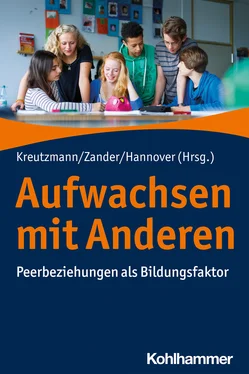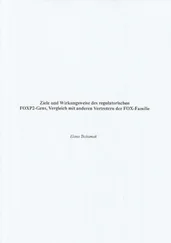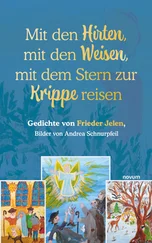Deci, E. L. & Ryan, R. M. (1985). Intrinsic motivation and self-determination in human behavior. New York: Plenum.
Deci, E. L. & Ryan, R. M. (2000). The »what« and »why« of goal pursuits: Human needs and the self-determination of behavior. Psychological inquiry, 11, 227–268.
DeLay, D., Laursen, B., Kiuru, N., Salmela-Aro, K. & Nurmi, J.-E. (2013). Selecting and retaining friends on the basis of cigarette smoking similarity. Journal of Research on Adolescence, 23, 464–473.
Engels, M. C., Colpin, H., Wouters, S., Van Leeuwen, K., Bijttebier, P., Van Den Noortgate, W. et al. (2019). Adolescents’ peer status profiles and differences in school engagement and loneliness trajectories: A person-centered approach. Learning and Individual Differences, 75, 101759.
Ennett, S. T. & Bauman, K. E. (1994). The contribution of influence and selection to adolescent peer group homogeneity: The case of adolescent cigarette smoking. Journal of Personality and Social Psychology, 67, 653–663.
Frenzel, A. C., Goetz, T., Pekrun, R. & Watt, H. M. G. (2010). Development of mathematics interest in adolescence: Influences of gender, family, and school context. Journal of Research on Adolescence, 20, 507–537.
Furrer, C. J., Skinner, E. A. & Pitzer, J. R. (2014). The influence of teacher and peer relationships on students’ classroom engagement and everyday motivational resilience. National Society for the Study of Education, 113, 101–123.
Gest, S. D., Madill, R. A., Zadzora, K. M., Miller, A. M. & Rodkin, P. C. (2014). Teacher management of elementary classroom social dynamics. Journal of Emotional and Behavioral Disorders, 22, 107–118.
Gottfried, A. E., Fleming, J. S. & Gottfried, A. W. (1994). Role of parental motivational practices in children’s academic intrinsic motivation and achievement. Journal of Educational Psychology, 86, 104–113.
Gottfried, A. E., Marcoulides, G. A., Gottfried, A. W., Oliver, P. H. & Guerin, D. W. (2007). Multivariate latent change modeling of developmental decline in academic intrinsic math motivation and achievement: Childhood through adolescence. International Journal of Behavioral Development, 31, 317–327.
Gremmen, M. C., Dijkstra, J. K., Steglich, C. & Veenstra, R. (2017). First selection, then influence: Developmental differences in friendship dynamics regarding academic achievement. Developmental Psychology, 53, 1356–1370.
Hamm, J. V., Schmid, L., Farmer, T. W. & Locke, B. (2011). Injunctive and descriptive peer group norms and the academic adjustment of rural early adolescents. Journal of Early Adolescence, 31, 41–73.
Harks, M. & Hannover, B. (2017). Sympathiebeziehungen unter Peers im Klassenzimmer: Wie gut wissen Lehrpersonen Bescheid? Zeitschrift für Erziehungswissenschaft, 20, 425–448.
Hartup, W. W. (1989). Social relationships and their developmental significance. American Psychologist, 44, 120–126.
Hinde, R. A. (1976). Interactions, relationships and social structure. Man, 11, 1–17.
Kindermann, T. A. (2007). Effects of naturally existing peer groups on changes in academic engagement in a cohort of sixth graders. Child Development, 78, 1186–1203.
Kindermann, T. A. (2016). Peer group influences on students’ academic motivation. In K. R. Wentzel & G. B. Ramani (Hrsg.), Handbook of social influences in school contexts. Social-emotional, motivation, and cognitive outcomes (S. 31–47). London: Taylor Francis.
Korpershoek, H., Harms, T., de Boer, H., van Kuijk, M. & Doolaard, S. (2016). A meta-analysis of the effects of classroom management strategies and classroom management programs on students’ academic, behavioral, emotional, and motivational outcomes. Review of Educational Research, 86, 643–680.
Krapp, A. (1999). Interest, motivation and learning: An educational-psychological perspective. European Journal of Psychology of Education, 14, 23–40.
Ladd, G.W., Herald-Brown, S. L. & Kochel, K. P. (2009). Peers and motivation. In K. R. Wentzel & A. Wigfield (Hrsg.), Handbook of motivation at school (S. 323–348). New York, NY: Taylor Francis.
Lapinski, M. K. & Rimal, R. N. (2005). An explication of social norms. Communication Theory, 15, 127–147.
Linnenbrink, E. A. & Pintrich, P. R. (2002). Motivation as an enabler for academic success. School Psychology Review, 31, 313–327.
Matelski, M. H. & Hogg M. A. (2015). Social psychology of group processes. In J. D. Wright (Hrsg.), International encyclopedia of the social and behavioral sciences (2. Aufl., S. 422–427). Elsevier.
Moore Partin, T. C., Robertson, R. E., Maggin, D. M., Oliver, R. M. & Wehby, J. H. (2009). Using teacher praise and opportunities to respond to promote appropriate student behavior. Preventing school failure: Alternative education for children and youth, 54, 172–178.
Pelkner, A. K., Günther, R. & Boehnke, K. (2002). Die Angst vor sozialer Ausgrenzung als leistungshemmender Faktor. Zeitschrift für Pädagogik, Beiheft, 45, 326–340.
Rambaran, J. A., Hopmeyer, A., Schwartz, D., Steglich, C., Badaly, D. & Veenstra, R. (2017). Academic functioning and peer influences: A short-term longitudinal study of network–behavior dynamics in middle adolescence. Child Development, 88, 523–543.
Rheinberg, F. (2008). Motivation (7., akt. Aufl.). Stuttgart: W. Kohlhammer.
Ryan, A. M. (2001). The peer group as a context for the development of young adolescent motivation and achievement. Child Development, 72, 1135–1150.
Shin, H. & Ryan, A. M. (2014). Early adolescent friendships and academic adjustment: Examining selection and influence processes with longitudinal social network analysis. Developmental Psychology, 50, 2462–2472.
Utley, C. A., Mortweet, S. L. & Greenwood, C. R. (1997). Peer-mediated instruction and interventions. Focus on Exceptional Children, 29, 1–23.
van den Berg, Y. H., Segers, E. & Cillessen, A. H. (2012). Changing peer perceptions and victimization through classroom arrangements: A field experiment. Journal of Abnormal Child Psychology, 40, 403–412.
Vaquera, E. & Kao, G. (2008). Do you like me as much as I like you? Friendship reciprocity and its effects on school outcomes among adolescents. Social Science Research, 37, 55–72.
Vollet, J. W., Kindermann, T. A. & Skinner, E. A. (2017). In peer matters, teachers matter: Peer group influences on students’ engagement depend on teacher involvement. Journal of Educational Psychology, 109, 635–652.
Wentzel, K. R., Barry, C. M. & Caldwell, K. A. (2004). Friendships in middle school: Influences on motivation and school adjustment. Journal of Educational Psychology, 96, 195–203.
Wentzel, K. R., Jablansky, S. & Scalise, N. R. (2020). Peer social acceptance and academic achievement: A meta-analytic study. Journal of Educational Psychology, 113, 157–180.
Wigfield, A. & Eccles, J. S. (2000). Expectancy-value theory of achievement motivation. Contemporary Educational Psychology, 25, 68–81.
Youniss, J. & Haynie, D. L. (1992). Friendship in adolescence. Journal of Developmental and Behavioral Pediatrics, 13, 59–66.
Youniss, J. & Smollar, J. (1985). Adolescent relations with mothers, fathers, and friends. Chicago: University of Chicago Press.
Zander, L., Kreutzmann, M. & Hannover, B. (2017). Peerbeziehungen im Klassenzimmer. Zeitschrift für Erziehungswissenschaft, 20, 353–386.
Конец ознакомительного фрагмента.
Текст предоставлен ООО «ЛитРес».
Прочитайте эту книгу целиком, купив полную легальную версию на ЛитРес.
Безопасно оплатить книгу можно банковской картой Visa, MasterCard, Maestro, со счета мобильного телефона, с платежного терминала, в салоне МТС или Связной, через PayPal, WebMoney, Яндекс.Деньги, QIWI Кошелек, бонусными картами или другим удобным Вам способом.












